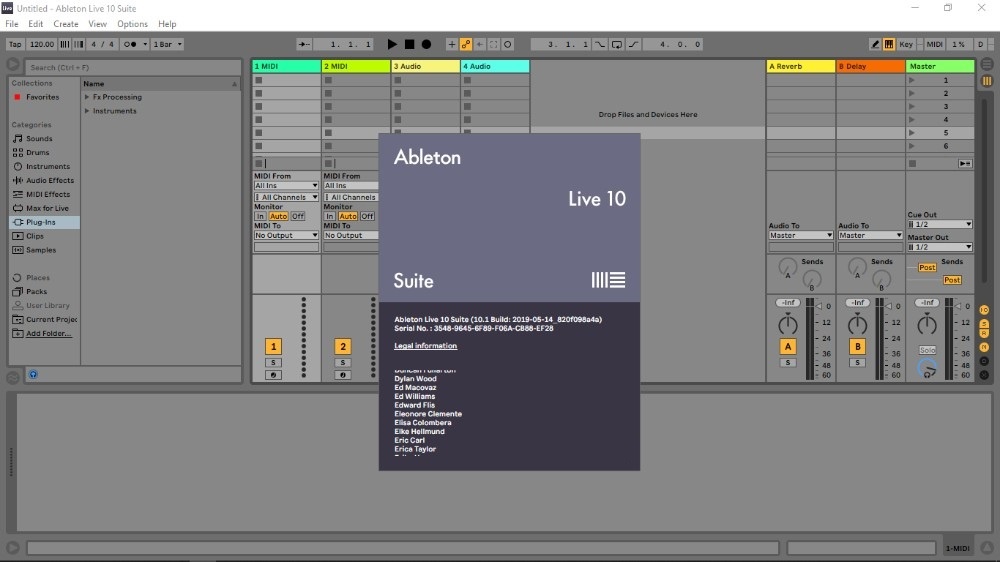Ableton Live 7 Legacy Pack
- Ableton Live 7 Legacy Package
- Ableton Live 7 Legacy Pack Free
- Ableton Live 7 Legacy Packs
- Ableton Live 7 Legacy Pack
IMGGhost Syndicate State 172 ABLETON LiVE TEMPLATEFANTASTiC 29 October 2020 348 MBWe named the pack STATE 172 because it’s our favourite BPM. Ableton Live meeting-place and website ELPHNT released an Ableton Live Pack recently that you can use to shape and design your drum sounds; it comes.

In this article, I'm going to explain how to recreate some of the key elements in Rihanna's track, We Found Love. The track has been written and produced by England's talented Calvin Harris. You can hear his distinctive synth sounds in this Rihanna track. I will be recreating these sounds in Ableton Live. I will be describing the Intro Synth sound, The Trance Lead sound that is introduced as well. Then I go on to give some tips on the build up section before it drops into the chorus.

Step 1 ' The Intro Synth
Let's first start with the intro synth line in the track. It is a simple two-chord pattern (A# and C#). For this synth sound I am going to attempt to recreate it using an Instrument Rack with the use of different audio waveforms.
First create an Instrument Rack. For the first chain, add a Simpler Instrument. I am going to start with an Analog Saw waveform. I have downloaded the Live 7 Legacy pack and have used the waveforms available in this pack (Under Live Devices > Instruments > Simpler > Live 7 Legacy). This is a great Live Pack that has an assortment of waveforms that can be used in the Simpler to build up interesting sounding layered synths.
Next up I have added a Piano sample (Live Devices > Instruments > Simpler > Piano and Keys > Keys-Acoustic Piano) to my next Chain. This piano sample adds a good attack to this sampled synth. To create a new chain simply right-click under the first chain and select '˜Create Chain'. You can also rename these chains so that from a quick look you know what sound is associated to each chain.
The third sample I have used in this layered synth is a spectral semi-square waveform (Live Devices > Instruments > Simpler > Live 7 Legacy > Spectral).
For the fourth chain I have used the Keys-Dirty-Organ preset (Live Devices > Instrument Rack > Organ) and have slightly tweaked it to fit in with the other elements of the layered synth.
To add some presence to the sound I have added some processing to enhance the layered synth.
I have used the EQ Eight to low cut the frequencies below 200 Hz. Next is a Compressor to add more punch to the synth. It has a Ratio of 2.56, an Attack of 9.47ms, a Release of 20.0ms and a Threshold of -21.5 dB. I have pulled the Output slightly down to -1.65dB.
To add some stereo spread to the synth I have used the Simple Delay. I have set L & R channels from Sync to Time, and have dialed in 24.4ms and 38.4ms respectively for the left and right channels. The Dry/Wet control is reduced to 29% so that the dry signal is still present.
To finish the processing off I have added a PingPong delay to bounce the delays around and create movement with the synth sound. I have set the delay to the 1st Sync rate. The Centre Frequency is set to 2.12 kHz and the Q to 2.56. There is a Feedback of 35% and the Dry/Wet is set at 32%.
On my Send Track I have added a Reverb plugin. Use the send on each track to choose how much reverb you want to apply to each track.
Step 2 ' The Trance Lead
To create the Trance Lead synth sound that comes in at about 00:24 in the original song (or at 01:14 in the above video), I am creating an Instrument Rack again. The first chain I have used the Lead-10 Saws preset (Instrument Rack > Synth Lead). This preset is a combination of multiple Saw waves to create a stabbing synth lead patch.
To add more attack to the sound, I have added a second chain in the Instrument Rack. I have used a Piano preset (Live Devices > Instrument Rack > Simpler > Piano and Keys). To this Piano chain I have added some slight compression to bring up the attack on the sample (Model: FB; Ratio: 2.00; Attack: 9.47ms; Release: 7.17ms; Threshold: -21.5dB).
As you can see I am a huge Simpler fan. But if you are feeling adventurous, jump into Operator for some Trance sounding synth sounds. But I'll stick with the Simpler in case you don't have the full Ableton Suite.
Step 3 ' The Build Up (Part 1)
There is a great build up in the track at 00:52 (01:44 in the video). There is a pitched synth note that builds up over the 8 bars. There is also a pumping white noise sample, which builds up under the pitched synth, and peaks just before the drop into the chorus. Let's not forget the claps and snares that are in there.
We will first tackle the synth that pitch bends up. I have used the same Intro synth but it is playing a syncopated pattern only on the A# note.

I have used the same syncopated pattern with the Trance Lead synth track.
For the pitched synth I have used, you guessed it, a Simpler. I have pulled in the Spectral 5 waveform (Live Devices > Instruments > Simpler > Live 7 Legacy > Spectral). This is a nice Digital sounding waveform that will sit nicely against my other two synths in this section. To the pitched synth I have added an EQ Eight with a 400Hz Low cut, a slight cut at 1.47 kHz and Gain of -10.2 dB and a slight peak at 5.94kHz, a Gain of 4.05dB and Q of 3.92.
Next is a Redux plugin to bitcrush/degrade the sound, a Saturator to dirty up the sound more, a Simple Delay (like we did with the Intro Synth) to add some stereo spread and a PingPong Delay to bounce the sound around the stereo field (Sync Rate: 3; The Centre Frequency: 5.05kHz; Q: 1.02; Feedback of 60% and the Dry/Wet is set to 25%).
Ableton Live 7 Legacy Package
Now for the pitch bending. Double-click the MIDI Region to bring up the MIDI data. Click on the E to bring up the Envelope Details. Choose MIDI Ctrl, and then Pitch Bend under that. Now draw in a rising pattern on the right window over the course of the 8 bars. Then play back the MIDI region and hear how the pitch rise sounds. Tweak as necessary.
Step 4 ' The Build Up (Part 2)
What adds to the build up is the pumping White Noise sample. Before I get to the White Noise sample, let me first program the Snare pattern. I have added a Snare sample to my Ableton project and have played a pattern that syncopates with the synth notes. Over the 8 bars the snare pattern starts adding in more hits until the end where there is a snare roll before the break into the next verse.
I have called up the Noise White Preset (Live Devices > Instruments > Simpler > Live 7 Legacy > Spectral). Over the course of the 8 bars I am going to automate the Filter Freq and Res. I have used the 24-pole High Pass Filter (HP24). Now add a Compressor and enable the Sidechain. Choose the snare track for the Audio From. The White Noise sample will be '˜ducked' when it picks up a signal from the Snare track. Check what compression settings work for you. For me I have 2.10 Ratio; 0.27 ms Attack; 20.0 ms Release; and -21.5dB Threshold.
Ableton Live 7 Legacy Pack Free
Use Automation to draw in node points for the Freq and Res on the Simpler Filter section.
After the first four bars a lower register pitch bend is introduced (01:00 in the original song, or 01:52 in the video). I have used a Simpler Instrument with a Digital Sine wave from the Live 7 Legacy pack. To dirty up the sound, I have used the Erosion, Redux and Overdrive plugins. I have pitched the A# note down and octave, and have then used the same technique above where I automate the Pitch Bend envelope over the remainder 4 bars.
After the build a solid four to the flour Kick comes in. Use any Kick with quite a subby low tone with a long release on the sub tones. Or you could layer two different kicks samples together. One with the punch and attack, and another with the low, sub '˜droney' tone. You can use the same Sidechain technique I used on the White Noise track on the other synth tracks but instead use the Kick as the Sidechain source. This will get the synths to create a pumping effect in the verses.
Here is the Build Up section:

Ableton Live 7 Legacy Packs
And here is the Chorus section after the build up with the solid four-to-the floor kick:

Step 5 ' Synth Differentiations
A technique that is quite handy to incorporate in your track is to simply add some elements in your mix to introduce differentiation in the song arrangement. You will hear at 01:23 (2:14 in the video) some of the synths drop out and you are left with just the drums and a single-note synth line. Try the same, get all the synths to drop out and keep one synth lead still going. Also drop the pitch of the pattern for more differentiation, as you can hear here:
I have dropped the pattern from A#2 down to D#1
Conclusion
In this article I have given some hints on how to achieve Calvin Harris's signature sounds. Calvin Harris has been honing his music production skills for years. This article is just scrapping the tip of the iceberg on his productions. Start incorporating these elements in your future productions to get a hint of his sound in your tunes.
For further tips on Ableton and its productions techniques take a look at the following tutorials: